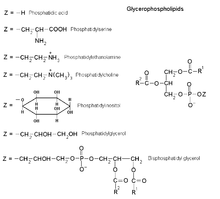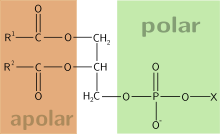Glycerophospholipid

Glycerophospholipids or phosphoglycerides are glycerol-based phospholipids. They are the main component of biological membranes.
Structures
The term glycerophospholipid signifies any derivative of glycerophosphoric acid that contains at least one O-acyl, or O-alkyl, or O-alk-1'- enyl residue attached to the glycerol moiety.[1]
The alcohol here is glycerol, to which two fatty acids and a phosphoric acid are attached as esters. This basic structure is a phosphatidate. Phosphatidate is an important intermediate in the synthesis of many phosphoglycerides. The presence of an additional group attached to the phosphate allows for many different phosphoglycerides.
By convention, structures of these compounds show the 3 glycerol carbon atoms vertically with the phosphate attached to carbon atom number three (at the bottom). Plasmalogens and phosphatidates are examples.[2]
Nomenclature and stereochemistry
In general, glycerophospholipids use a "sn" notation, which stands for stereospecific numbering. When the letters "sn" appear in the nomenclature, by convention the hydroxyl group of the second carbon of glycerol (sn-2) is on the left on a Fischer projection. The numbering follows the one of Fischer's projections, being sn-1 the carbon at the top and sn-3 the one at the bottom.
The advantage of this particular notation is that the spatial conformation (R or L) of the glycero-molecule is determined intuitively by the residues on the positions sn-1 and sn-3.
For example sn-glycero-3-phosphoric acid and sn-glycero-1-phosphoric acid are enantiomers.
Examples of glycerophospholipids
- Plasmalogens
Plasmalogens are a type of phosphoglyceride. The first carbon of glycerol has a hydrocarbon chain attached via an ether, not ester, linkage. The linkages are more resistant to chemical attack than ester linkages are. The second (central) carbon atom has a fatty acid linked by an ester. The third carbon links to an ethanolamine or choline by means of a phosphate ester. These compounds are key components of the membranes of muscles and nerves.
- Phosphatidates
Phosphatidates are lipids in which the first two carbon atoms of the glycerol are fatty acid esters, and the 3 is a phosphate ester. The phosphate serves as a link to another alcohol-usually ethanolamine, choline, serine, or a carbohydrate. The identity of the alcohol determines the subcategory of the phosphatidate. There is a negative charge on the phosphate and, in the case of choline or serine, a positive quaternary ammonium ion. (Serine also has a negative carboxylate group.) The presence of charges give a "head" with an overall charge. The phosphate ester portion ("head") is hydrophilic, whereas the remainder of the molecule, the fatty acid "tail", is hydrophobic. These are important components for the formation of lipid bilayers.
Phosphatidylethanoamines, phosphatidylcholines, and other phospholipids are examples of phosphatidates.
- Phosphatidylcholines
Phosphatidylcholines are lecithins. Choline is the alcohol, with a positively charged quaternary ammonium, bound to the phosphate, with a negative charge. Lecithins are present in all living organisms. An egg yolk has a high concentration of lecthins- which are commercially important as an emulsifying agent in products such as mayonnaise. Lecithins are also present in brain and nerve tissue.
- Other phospholipids
There are many other phospholipids, some of which are glycolipids. The glycolipids include phosphatidyl sugars where the alcohol functional group is part of a carbohydrate. Phosphatidyl sugars are present in plants and certain microorganisms. A carbohydrate is very hydrophilic due to the large number of hydroxyl groups present.
Uses
Use in membranes
One of a glycerophospholipid's functions is to serve as a structural component of cell membranes. The cell membrane seen under the electron microscope consists of two identifiable layers, or "leaflets", each of which is made up of an ordered row of glycerophospholipid molecules. The composition of each layer can vary widely depending on the type of cell.
- For example, in human erythrocytes the cytosolic side (the side facing the cytosol) of the plasma membrane consists mainly of phosphatidylethanolamine, phosphatidylserine, and phosphatidylinositol.
- By contrast, the exoplasmic side (the side on the exterior of the cell) consists mainly of phosphatidylcholine and sphingomyelin, a type of sphingolipid.
Each glycerophospholipid molecule consists of a small polar head group and two long hydrophobic chains. In the cell membrane, the two layers of phospholipids are arranged as follows:
- the hydrophobic tails point to each other and form a fatty, hydrophobic center
- the ionic head groups are placed at the inner and outer surfaces of the cell membrane
This is a stable structure because the ionic hydrophilic head groups interact with the aqueous media inside and outside the cell, whereas the hydrophobic tails maximize hydrophobic interactions with each other and are kept away from the aqueous environments. The overall result of this structure is to construct a fatty barrier between the cell's interior and its surroundings.
Use in emulsification
Glycerophospholipids can also act as an emulsifying agent to promote dispersal of one substance into another. This is sometimes used in candy making and ice-cream making.
Glycerolphospholipids in the brain
Neural membranes contain several classes of glycerophospholipids which turnover at different rates with respect to their structure and localization in different cells and membranes. The glycerophospholipid composition of neural membranes greatly alters their functional efficacy. The length of glycerophospholipid acyl chain and the degree of saturation are important determinants of many membrane characteristics including the formation of lateral domains that are rich in polyunsaturated fatty acids. Receptor-mediated degradation of glycerophospholipids by phospholipases A(l), A(2), C, and D results in generation of second messengers, such as prostaglandins, eicosanoids, platelet activating factor and diacylglycerol. Thus, neural membrane phospholipids are a reservoir for second messengers. They are also involved in apoptosis, modulation of activities of transporters, and membrane-bound enzymes. Marked alterations in neural membrane glycerophospholipid composition have been reported to occur in neurological disorders. These alterations result in changes in membrane fluidity and permeability. These processes along with the accumulation of lipid peroxides and compromised energy metabolism may be responsible for the neurodegeneration observed in neurological disorders.[3]
Glycerophospholipid Metabolism
The metabolism of glycerophospholipids is different in eukaryotes and prokaryotes. Synthesis in prokaryotes involves the synthesis of glycerophospholipids phosphatidic acid and polar head groups. Phosphatidic acid synthesis in eukaryotes is different, there are two routes, one to the other toward phosphatidylcholine and phosphatidylethanolamine.
See also
References
- ↑ IUPAC Gold Book. http://goldbook.iupac.org/G02648.html
- ↑ Yong-Mei Zhang and Charles O. Rock (2008). "Thematic Review Series: Glycerolipids. Acyltransferases in bacterial glycerophospholipid synthesis". J Lipid Res. 49 (9): 1867–1874. doi:10.1194/jlr.R800005-JLR200. PMC 2515527. PMID 18369234.
- ↑ garcia, christina. "Metabolism of glycerophospholipids".
External links
- Glycerophospholipids at the US National Library of Medicine Medical Subject Headings (MeSH)
- Diagram at uca.edu
| ||||||||||||||||||||||||||||||||||||||

